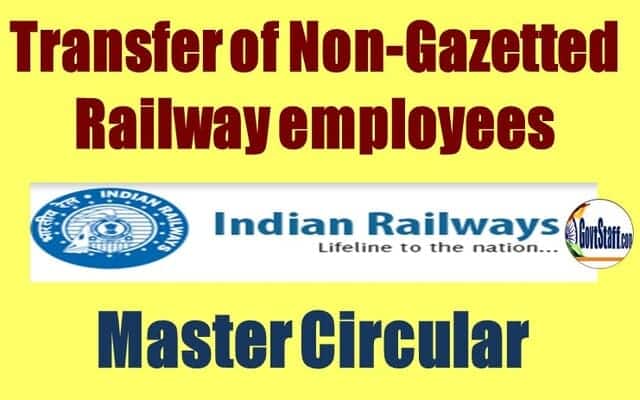Master Circular No. 24 on Transfer of Non-Gazetted Railway employees
Master Circular No. 24
भारत सरकार GOVERNMENT OF INDIA
रेल मंत्रालय MINISTRY OF RAILWAYS
(रेलवे बोर्ड RAILWAY BOARD)
No. E(NG)I/2019/TR/10
New Delhi, dated 17.08.2023
The General Managers (P)
All Indian Railways,
Production Units & others.
Sub:- Transfer of Non-Gazetted Railway employees — Master Circular.
Railway Board has issued instructions from time to time through various letters/instructions on the subject of transfer of Non-Gazetted Railway employees under the Zonal Railways. Based on instructions issued on the subject till 1991, Master Circular no 24 on Transfer was issued on 8.04.1991. The Master Circular has since been updated duly incorporating all the instructions issued so far on the subject for the information and guidance of all concerned.
2. Transfer means the movement of a Railway employee from one headquarter station in which he is employed to another such station, either;
(i) To take up the duties of a new post; or
(ii) In consequence of a change of his headquarter and seniority units.
(Ref: Rule 226 to 231 — Indian Railway Establishment Code, Vol. I, 1985 Edition)
3. Transfer may be ordered either on a temporary basis or on a basis otherwise than temporary. Transfer is not a punishment.
3.1 Frequent transfer of Railway employees should not be resorted to. Wherever the transfer of a Railway employee is temporary, the same should be mentioned in the transfer order.
(Ref:- Board’s letter No. E(NG)I-81/TR/19 dated 23.5.81).
4. Transfers otherwise than on temporary basis, are necessitated by administrative requirements or occasioned by consideration of requests received from the Railway employees.
4.1. Transfer of a Railway employee ordered as a result of his promotion should be carried out by the employee as early as possible in his own interest.
4.2 (i) Whenever any curtailment in a cadre takes place and Railway employees have to be transferred, as a general rule, the junior most employees should be transferred first.
(Ref: Board’s letter No. E(NG)66/TR2/20 dated 27.7.66)
(ii) If there is closure of activity on a particular station on a Railway like closing down a shed or a particular establishment necessitating transfer of Railway employee enmasse, the matter should be discussed with the Labour, to help in proper arrangement being made for dealing with the human problems that might arise in such cases.
(Ref: Board’s letter No. E(NG)II/77/TR/21 dated 10.06.77)
5. Procedure for processing transfer application:
Railways should follow the following guidelines while processing the transfers of Railway employees from one Unit/Division/Railway to another Unit/Division/Railway:
(i) The application containing all the necessary details should be made in as many copies as the levels/offices through which the application has to pass through including the Unit/Division/Railway to which the transfer is sought for.
(ii) All the copies should have a recent passport size photograph of the employee firmly affixed/pasted on the top right hand corner of the application.
(iii) The application should be accompanied by an additional identical passport size photograph which may be affixed/pasted similarly on the Memorandum/Order sparing the employee for transfer as and when issued.
(iv) The immediate Supervisor/Officer of the employee concerned before forwarding the application for further necessary action should attest the photograph affixed on each copy of the application in such a manner that the signature and the rubber stamp below that appear partially on the photograph and partially on the paper outside the photograph.
(v) The rubber stamp should clearly indicate the name and designation of the Supervisor/Officer attesting and forwarding the application.
(vi) Each level/Office will retain a copy of the application complete in all respects as per details mentioned above before forwarding the same to the higher authority or Unit to which the transfer has been sought for, as the case may be.
(vii) The application should be registered and appropriate priority number allotted as per extant procedure and the employee advised of the same.
(viii) After the request for transfer has been accepted and necessary orders issued by the competent authority, Memorandum/Order sparing the employee should have the photograph of the employee (received from him at the time he made the request initially) pasted on it duly attested in the manner indicted in (iv) above. The Memorandum/Order should also have the signature of the transferred employee and his left thumb impression both of which should be duly attested by the officer signing the Memorandum/Order with his name and designation appearing below the signature.
(ix) When the transferred employee presents himself in the new Unit with the original Memo sparing him for transfer, necessary details like his photograph, signature etc should be carefully matched before he is allowed to join. If, in any case, the details match prima-facie but still reasonable doubt persists and consultation/enquiry/verification of genuineness is warranted with the Railway/Division/Unit from which the employee has been transferred, the same can be done as soon as possible but within a month of his joining.
(x) All communications regarding transfer should be signed by a Gazetted Personnel Officer with his name and designation appearing below the signature.
(xi) The LPC should be issued immediately and signed by a Gazetted Accounts Officer with his name and designation appearing below the signature.
(xii) LPC should be sent under a covering letter to the new Unit to which the employee has been transferred through special messenger as far as possible whose identity should be established and noted at the time of accepting the document.
(xiii) The Service Book of the employee concerned duly completed should also be sent to the new Unit in the same manner as in (xii) above.
5.2 The above procedure will apply mutatis mutandis to all transfers including transfers on administrative ground and transfer on mutual exchange basis.
(Ref:- Board’s letter No. E(NG)I-2001/TR/16 dated 21.11.2001 and E(NG)I-2014/TR/14 dated 07.04.2015)


COMMENTS